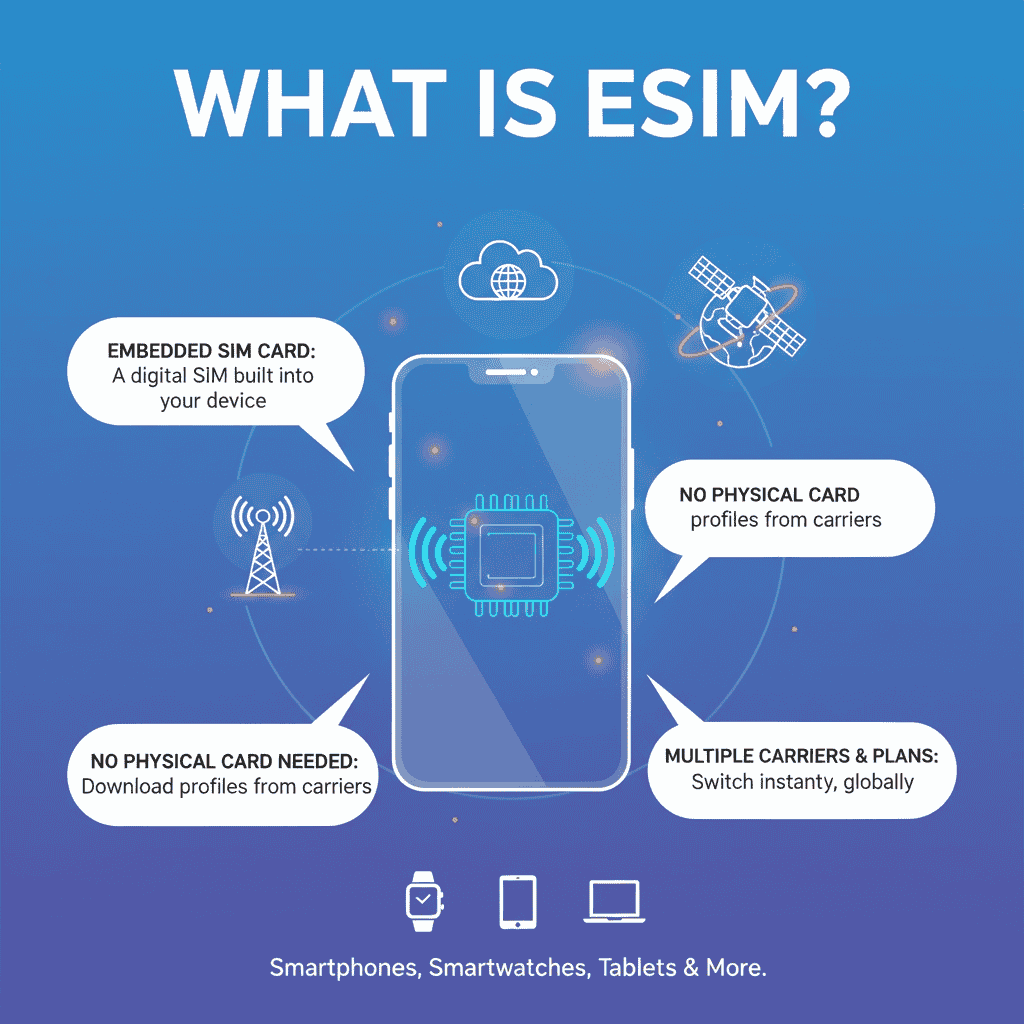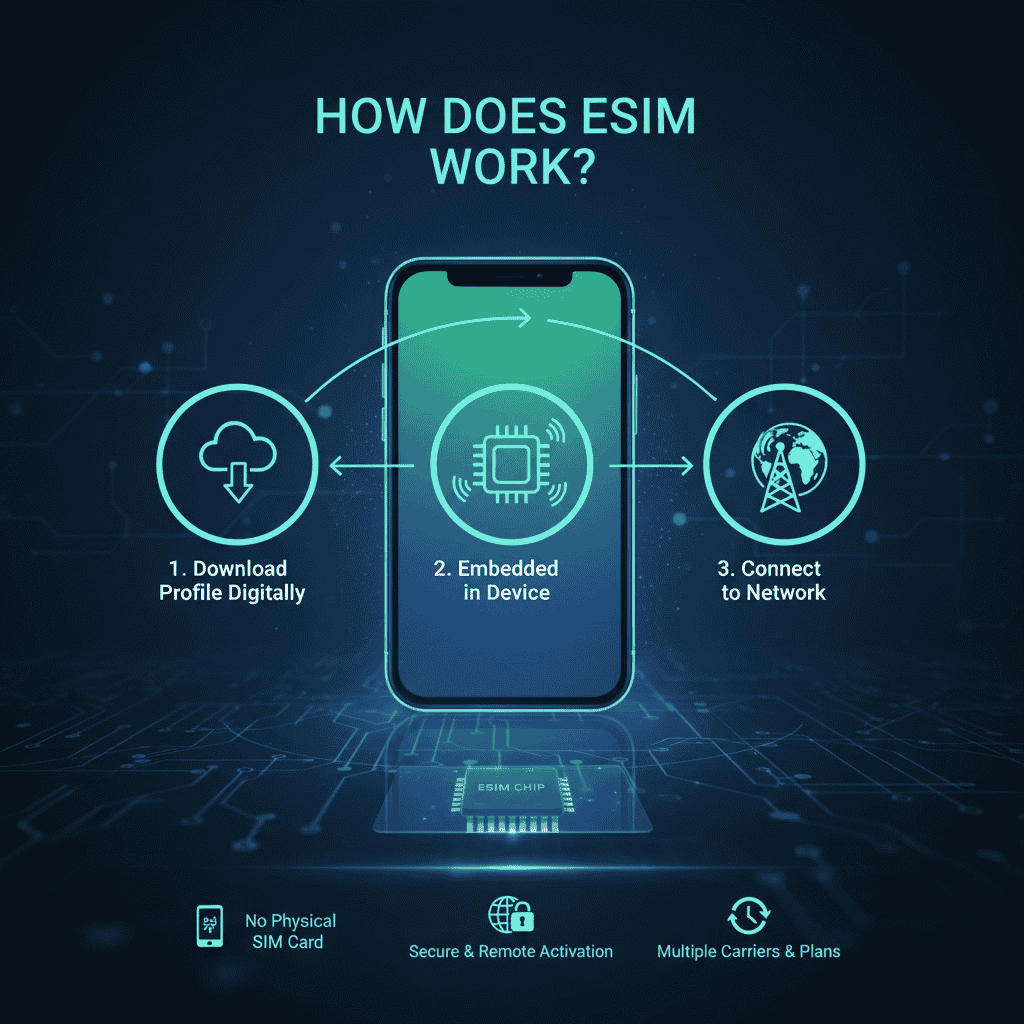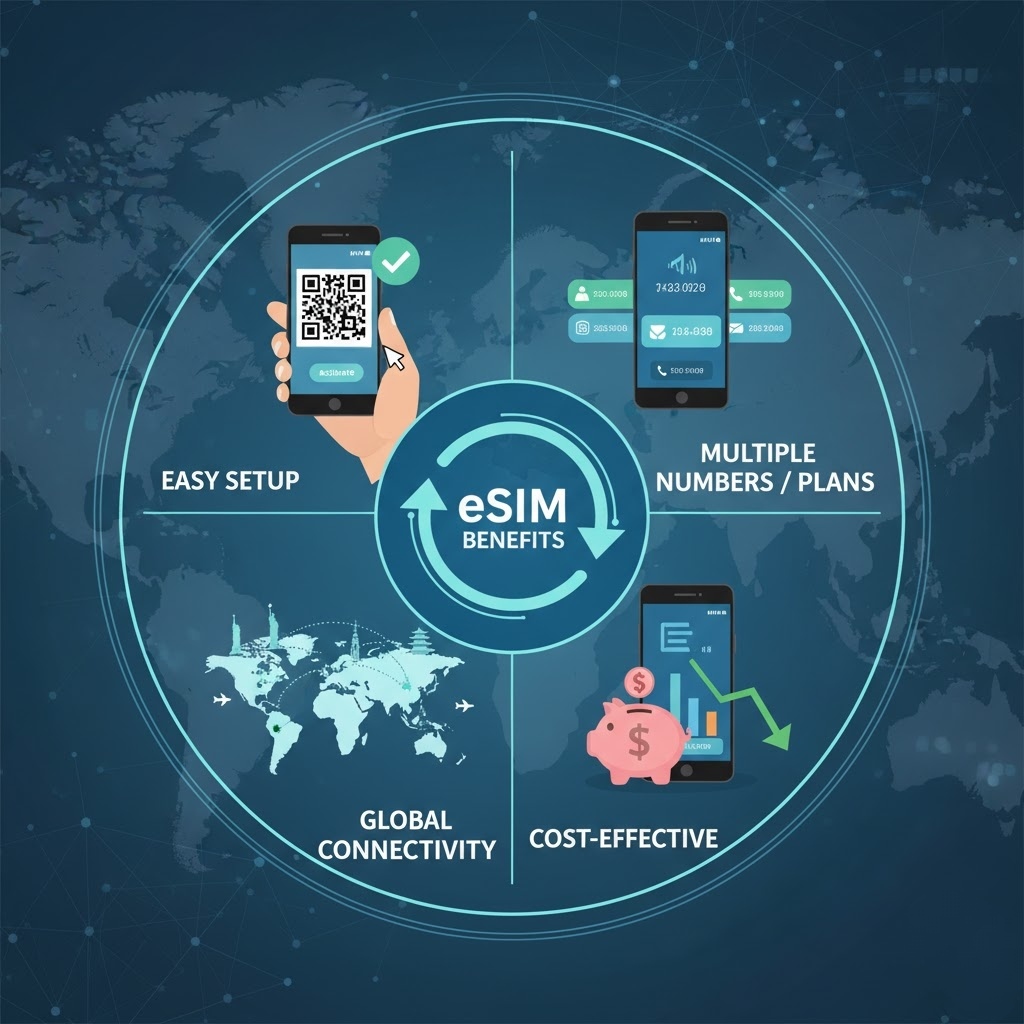
If you have changed phones or carriers, you know the hassles of removing tiny SIM cards from a phone. However, what if you did not need a physical SIM card, at all? That is precisely what an eSIM does. So what is eSIM and what does it do? In essence, an eSIM is a digital version of your old SIM card-it is designed within your phone, smartwatch, or tablet and can be programmed remotely by your carrier.
It is changing the way we connect to mobile networks, travel abroad, and manage multiple phone lines and numbers. In this article we will share everything you need to know about eSIM-how it works, the pros and cons, its compatibility for mobile devices, and why it is set to be the future of connectivity with mobile devices.
What is eSIM?
eSIM, or embedded SIM, is a tiny reprogrammable chip that’s already installed in your device. Where you can take a physical SIM card in or out, the eSIM is actually soldered onto your device’s motherboard. The new service can be turned on by scanning a QR code or downloading a carrier profile; there’s no physical insertion or replacement of anything required.
Put another way, eSIM enables you to digitally connect to your mobile network. It keeps your carrier profile, phone number, and network settings as if it were a regular SIM card, but without the plastic card itself.
How Does eSIM Work?

An eSIM works in a pretty straightforward way, but it’s clever. Once you get a new plan, your provider will send you a QR code or an activation link. Simply scanning it will load your provider’s details onto your eSIM chip.
We can also think of it as a short 5-step process-wise review of the principals:
- eSIM chip is already there in your device.
- eSIM supported mobile carrier and plan is your choice.
- To activate the plan, the carrier gives you a QR code or an app.
- The code is scanned or the app is used to download your eSIM profile.
- The device is thus connected to the carrier’s network.
It is also possible to have multiple eSIM profiles saved on a single device, thereby enabling a user to be able to choose a carrier or number on a whim without the need to physically change SIM cards.
Benefits of Using eSIM

The trend of eSIM has been escalating very rapidly, and rightly so. It is packed with a whole lot of benefits as compared to the traditional SIM card.
1. Easy Activation and Setup
For an eSIM, the only thing you need to do is go online and within a short time, your eSIM will be activated. No more losing SIM ejector pins or having to go to stores.
2. Dual SIM Flexibility
Many smart devices will enable you to operate one physical SIM and one eSIM or have two eSIM profiles. It is a fabulous idea to use one gadget for work and personal numbers.
3. Perfect for Travelers
There is no doubt that international travelers are keen on the idea of eSIM. The reason being that they have the luxury of adding a local data plan and still keep their number. Hence, there is no need to buy or replace local SIM cards when abroad.
4. Eco-Friendly Technology
The introduction of eSIM is a way of reducing tech waste. There is no plastic SIM card nor packaging hence no waste. It may be a small step, but it is very valuable.
5. Better Device Design
eSIM is an advanced technology that requires a smaller area for installation; therefore, a mobile phone producer will be able to use that extra space for a larger battery or any other hardware improvements.
Disadvantages of eSIM

Though eSIMs bring a lot of advantages, there are still a few cons that need to be taken into account.
- Limited carrier support: A few mobile networks are still not supporting eSIM, especially in less developed areas.
- Device compatibility: It is possible that older models do not have the eSIM component.
- Not as good as in case of frequent changing of phones: It may be necessary to ask your carrier to reactivate the number if you want to transfer it to another device.
- Possible privacy issues: Since eSIMs are remotely programmable, some users are concerned about carrier control and security.
Nevertheless, most of these problems are being taken care of as the technology is evolving.
How to Activate an eSIM
Generally, eSIM activation is a straightforward process. Most of the steps appear similar for both iPhones and Android devices.
iPhone:
- Navigate to Settings > Mobile > Add an eSIM
- Using your iPhone, scan the QR code which is given by your network provider
- Set up will be done once you follow the instruction popping up on the display
Android (Samsung, Pixel):
- Launch the Settings > Connectivity > SIM Manager application
- Tap “Add eSIM”
- Locate the QR code or local profile and obtain the information
The device will be connected to the chosen network without the need for a conventional SIM card in a few moments.
eSIM vs Physical SIM: What’s the Difference?
| Feature | eSIM | Physical SIM |
| Form | Embedded chip | Removable card |
| Setup | Remote activation | Insert manually |
| Switching carriers | Instant | Requires new card |
| Storage capacity | Multiple profiles | One carrier only |
| Securit | Harder to steal | Easier to remove |
| Eco impact | Minimal | Plastic waste |
Is eSIM Safe and Secure?
Yes, eSIM technology is compliant with rigid worldwide criteria established by the GSM Association (GSMA). The information kept on an eSIM is secured by encryption and is inaccessible without the right permission.
As a matter of fact, eSIMs have the potential to be more secure than physical SIM cards in that:
- It is not possible for them to be taken off or cloned in a simple way.
- Devices that are lost or stolen may have their data erased via a remote control.
- One carrier authentication that is verified is required for activation.
In general, eSIM is a good choice in terms of both handy usage and stronger security for the majority of users.
The Future of eSIM
eSIM usage is getting more and more popular. A majority of the smartphone manufacturers – such as Apple, Samsung, and Google – are gradually transitioning to eSIM-only models. The iPhone 14 is a good example: it comes without a SIM card slot in the U.S.
So, the next things we can be sure of are:
- It won’t be long until carriers everywhere will be supporting eSIM.
- You will be able to change your mobile plan directly from the device settings more conveniently.
- Greater integration with wearables, cars, and IoT devices.
eSIM is a substantial move towards a fully digital and flexible mobile ecosystem.
Conclusion
What is eSIM really? It is not just a tech upgrade – it is a smarter, more environmentally friendly and more flexible way to keep in touch. eSIM technology does away with the need for physical SIM cards, makes it easy to change carriers, and is in line with the world’s move towards a completely digital way of connecting.
If you are a traveler who is always on the move, a tech enthusiast, or simply a person who appreciates the convenience, then eSIM is definitely something to consider. With the continuous development of networks and gadgets, eSIM will be the norm for mobile communication anywhere in the world.
FAQs
What is eSIM in simple terms?
An eSIM is a digital SIM built into your device. It connects you to your mobile network without needing a physical card.
Can I use both eSIM and a regular SIM at the same time?
Yes, many modern phones support dual SIM — one eSIM and one physical SIM.
Can I transfer my eSIM to another phone?
Yes, but you’ll likely need to deactivate it on the old device and reactivate it with your carrier on the new one.
